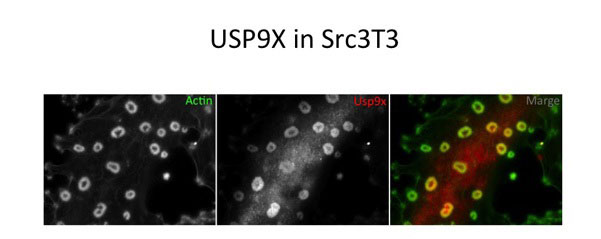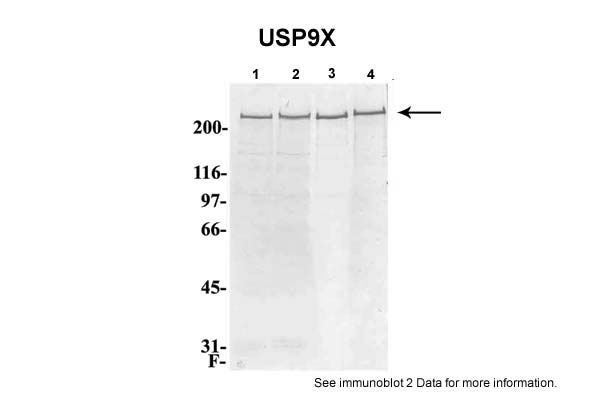USP9X antibody - C-terminal region
Rabbit Polyclonal Antibody
- 产品详情
- 文献引用 : 1
- 实验流程
Application
| WB, IHC |
|---|---|
| Primary Accession | Q93008 |
| Other Accession | NM_001039590, NP_001034679 |
| Reactivity | Human, Mouse, Rat, Rabbit, Pig, Dog, Horse, Bovine |
| Predicted | Human, Mouse, Rat, Rabbit, Pig, Chicken, Dog, Horse, Bovine |
| Host | Rabbit |
| Clonality | Polyclonal |
| Calculated MW | 290463 Da |
| Gene ID | 8239 |
|---|---|
| Alias Symbol | DFFRX, FAF, FAM |
| Other Names | Probable ubiquitin carboxyl-terminal hydrolase FAF-X, 3.4.19.12, Deubiquitinating enzyme FAF-X, Fat facets in mammals, hFAM, Fat facets protein-related, X-linked, Ubiquitin thioesterase FAF-X, Ubiquitin-specific protease 9, X chromosome, Ubiquitin-specific-processing protease FAF-X, USP9X, DFFRX, FAM, USP9 |
| Format | Liquid. Purified antibody supplied in 1x PBS buffer with 0.09% (w/v) sodium azide and 2% sucrose. |
| Reconstitution & Storage | Add 50 ul of distilled water. Final anti-USP9X antibody concentration is 1 mg/ml in PBS buffer with 2% sucrose. For longer periods of storage, store at 20°C. Avoid repeat freeze-thaw cycles. |
| Precautions | USP9X antibody - C-terminal region is for research use only and not for use in diagnostic or therapeutic procedures. |
| Name | USP9X {ECO:0000303|PubMed:18254724, ECO:0000312|HGNC:HGNC:12632} |
|---|---|
| Function | Deubiquitinase involved both in the processing of ubiquitin precursors and of ubiquitinated proteins (PubMed:18254724, PubMed:19135894, PubMed:22371489, PubMed:25944111, PubMed:29626158, PubMed:30914461, PubMed:37454738). May therefore play an important regulatory role at the level of protein turnover by preventing degradation of proteins through the removal of conjugated ubiquitin (PubMed:18254724, PubMed:19135894, PubMed:22371489, PubMed:25944111, PubMed:29626158, PubMed:30914461, PubMed:37454738). Specifically hydrolyzes 'Lys-11'-, followed by 'Lys-63'-, 'Lys-48'- and 'Lys-6'- linked polyubiquitins chains (PubMed:30914461). Essential component of TGF-beta/BMP signaling cascade (PubMed:19135894). Specifically deubiquitinates monoubiquitinated SMAD4, opposing the activity of E3 ubiquitin-protein ligase TRIM33 (PubMed:19135894). Deubiquitinates alkylation repair enzyme ALKBH3 (PubMed:25944111). OTUD4 recruits USP7 and USP9X to stabilize ALKBH3, thereby promoting the repair of alkylated DNA lesions (PubMed:25944111). Deubiquitinates RNA demethylase enzyme ALKBH5, promoting its stability (PubMed:37454738). Deubiquitinates mTORC2 complex component RICTOR at 'Lys-294' by removing 'Lys-63'-linked polyubiquitin chains, stabilizing RICTOR and enhancing its binding to MTOR, thus promoting mTORC2 complex assembly (PubMed:33378666). Regulates chromosome alignment and segregation in mitosis by regulating the localization of BIRC5/survivin to mitotic centromeres (PubMed:16322459). Involved in axonal growth and neuronal cell migration (PubMed:24607389). Regulates cellular clock function by enhancing the protein stability and transcriptional activity of the core circadian protein BMAL1 via its deubiquitinating activity (PubMed:29626158). Acts as a regulator of peroxisome import by mediating deubiquitination of PEX5: specifically deubiquitinates PEX5 monoubiquitinated at 'Cys-11' following its retrotranslocation into the cytosol, resetting PEX5 for a subsequent import cycle (PubMed:22371489). Deubiquitinates PEG10 (By similarity). Inhibits the activation of the Hippo signaling pathway via deubiquitination of AMOTL2 at 'Lys-347' and 'Lys-408' which prohibits its interaction with and activation of LATS2. Loss of LATS2 activation and subsequent loss of YAP1 phosphorylation results in an increase in YAP1-driven transcription of target genes (PubMed:26598551, PubMed:34404733). |
| Cellular Location | Cytoplasm, cytosol. Cell projection, growth cone. Cytoplasm, cytoskeleton, cilium axoneme |
| Tissue Location | Widely expressed in embryonic and adult tissues. |
Research Areas
For Research Use Only. Not For Use In Diagnostic Procedures.

Application Protocols
Provided below are standard protocols that you may find useful for product applications.
REFERENCES
Jones M.H.,et al.Hum. Mol. Genet. 5:1695-1701(1996).
Jones M.H.,et al.Hum. Mol. Genet. 6:334-335(1996).
Ross M.T.,et al.Nature 434:325-337(2005).
Yu W.,et al.Submitted (JUN-1998) to the EMBL/GenBank/DDBJ databases.
Rush J.,et al.Nat. Biotechnol. 23:94-101(2005).
终于等到您。ABCEPTA(百远生物)抗体产品。
点击下方“我要评价 ”按钮提交您的反馈信息,您的反馈和评价是我们最宝贵的财富之一,
我们将在1-3个工作日内处理您的反馈信息。
如有疑问,联系:0512-88856768 tech-china@abcepta.com.






















 癌症的基本特征包括细胞增殖、血管生成、迁移、凋亡逃避机制和细胞永生等。找到癌症发生过程中这些通路的关键标记物和对应的抗体用于检测至关重要。
癌症的基本特征包括细胞增殖、血管生成、迁移、凋亡逃避机制和细胞永生等。找到癌症发生过程中这些通路的关键标记物和对应的抗体用于检测至关重要。 为您推荐一个泛素化位点预测神器——泛素化分析工具,可以为您的蛋白的泛素化位点作出预测和评分。
为您推荐一个泛素化位点预测神器——泛素化分析工具,可以为您的蛋白的泛素化位点作出预测和评分。 细胞自噬受体图形绘图工具为你的蛋白的细胞受体结合位点作出预测和评分,识别结合到自噬通路中的蛋白是非常重要的,便于让我们理解自噬在正常生理、病理过程中的作用,如发育、细胞分化、神经退化性疾病、压力条件下、感染和癌症。
细胞自噬受体图形绘图工具为你的蛋白的细胞受体结合位点作出预测和评分,识别结合到自噬通路中的蛋白是非常重要的,便于让我们理解自噬在正常生理、病理过程中的作用,如发育、细胞分化、神经退化性疾病、压力条件下、感染和癌症。







